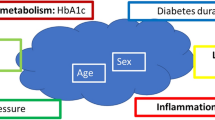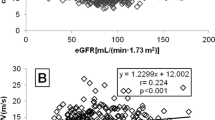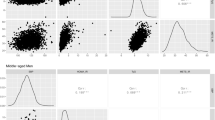Abstract
Increased arterial stiffness and the presence of metabolic syndrome (MS) have been shown to predict cardiovascular events in patients with primary hypertension. We investigated the relationship between a recently proposed index of arterial stiffness derived from ambulatory blood pressure (BP) monitoring and MS in 156 untreated, non-diabetic patients with primary hypertension. Ambulatory arterial stiffness index (AASI) was defined as 1 minus the regression slope of diastolic over systolic BP readings obtained from 24-h recordings. A modified National Cholesterol Education Program definition for MS was used, with body mass index replacing waist circumference. The prevalence of MS was 23%. Patients with MS were more frequently male (0.0291) and had increased serum uric acid (P=0.0005), high-sensitivity C-reactive protein (P=0.0259), as well as total and low-density lipoprotein (LDL)-cholesterol (P=0.0374 and P=0.0350, respectively) as compared to those without MS. After adjusting for these confounders, the association between AASI and the presence of MS was statistically significant (P=0.0257). Moreover, the prevalence of increased AASI (upper tertile, that is ⩾0.550) was greater in patients with MS (P=0.0156). After adjusting for age and 24-h mean BP, the presence of MS entailed a more than twofold greater risk for increased AASI (0.0280). MS is associated with increased AASI in non-diabetic patients with primary hypertension. These data support the role of this new index of arterial stiffness as a marker of risk and help to explain the high cardiovascular morbidity and mortality that is observed in hypertensive patients with MS.
This is a preview of subscription content, access via your institution
Access options
Subscribe to this journal
Receive 12 digital issues and online access to articles
$119.00 per year
only $9.92 per issue
Buy this article
- Purchase on Springer Link
- Instant access to full article PDF
Prices may be subject to local taxes which are calculated during checkout

Similar content being viewed by others
References
Isomaa B, Almgren P, Tuomi T, Forsen B, Lahti K, Nissen M et al. Cardiovascular morbidity and mortality associated with the metabolic syndrome. Diabetes Care 2001; 24: 683–689.
van Popele NM, Grobbee DE, Bots ML, Asmar R, Topouchian J, Reneman RS et al. Association between arterial stiffness and atherosclerosis: the Rotterdam Study. Stroke 2001; 32: 454–460.
Blacher J, Safar ME, Guerin AP, Pannier B, Marchais SJ, London GM . Aortic pulse wave velocity index and mortality in end-stage renal disease. Kidney Int 2003; 63: 1852–1860.
Laurent S, Boutouyrie P, Asmar R, Gautier I, Laloux B, Guize L et al. Aortic stiffness is an independent predictor of all-cause and cardiovascular mortality in hypertensive patients. Hypertension 2001; 37: 1236–1241.
Cruickshank K, Riste L, Anderson SG, Wright JS, Dunn G, Gosling RG . Aortic pulse-wave velocity and its relationship to mortality in diabetes and glucose intolerance: an integrated index of vascular function? Circulation 2002; 106: 2085–2090.
Li Y, Wang JG, Dolan E, Gao PJ, Guo HF, Nawrot T et al. Ambulatory arterial stiffness index derived from 24-h ambulatory blood pressure monitoring. Hypertension 2006; 47: 359–364.
Leoncini G, Ratto E, Viazzi F, Vaccaro V, Parodi A, Falqui V et al. Increased ambulatory arterial stiffness index is associated with target organ damage in primary hypertension. Hypertension 2006; 48: 397–402.
Dolan E, Thijs L, Li Y, Atkins N, McCormack P, McClory S et al. Ambulatory arterial stiffness index as a predictor of cardiovascular mortality in the Dublin Outcome Study. Hypertension 2006; 47: 365–370.
Schillaci G, Pirro M, Vaudo G, Mannarino MR, Savarese G, Pucci G et al. Metabolic syndrome is associated with aortic stiffness in untreated essential hypertension. Hypertension 2005; 45: 1078–1082.
Nakanishi N, Suzuki K, Tatara K . Clustered features of the metabolic syndrome and the risk for increased aortic pulse wave velocity in middle-aged Japanese men. Angiology 2003; 54: 551–559.
Pontremoli R, Sofia A, Ravera M, Nicolella C, Viazzi F, Tirotta A et al. Prevalence and clinical correlates of microalbuminuria in essential hypertension. The MAGIC study. Hypertension 1997; 30: 1135–1143.
Cockcroft DW, Gault MH . Prediction of creatinine clearance from serum creatinine. Nephron 1976; 16: 31–41.
Friedewald WT, Levy RI, Fredrickson DS . Estimation of the concentration of low density lipoprotein cholesterol in plasma without use of the preparative ultracentrifuge. Clin Chem 1972; 18: 499–502.
Executive summary of the Third Report of the National Cholesterol Education Program (NCEP). Expert Panel on Detection, Evaluation, and Treatment of High Blood Cholesterol in adults (Adult Treatment Panel III). JAMA 2001; 285: 2486–2497.
Genuth S, Alberti KG, Bennett P, Buse J, Defronzo R, Kahn R et al. Expert Committee on the Diagnosis and Classification of Diabetes Mellitus. Follow-up report on the diagnosis of diabetes mellitus. Diabetes Care 2003; 26: 3160–3167.
Ahluwalia N, Drouet L, Ruidavets JB, Perret B, Amar J, Boccalon H et al. Metabolic syndrome is associated with markers of subclinical atherosclerosis in a French population-based sample. Atherosclerosis 2006; 186: 345–353.
Scuteri A, Najjar SS, Muller DC, Andres R, Hougaku H, Metter EJ et al. Metabolic syndrome amplifies the age-associated increases in vascular thickness and stiffness. J Am Coll Cardiol 2004; 43: 1388–1395.
Safar ME, Thomas F, Blacher J, Nzietchueng R, Bureau JM, Pannier B et al. Metabolic syndrome and age-related progression of aortic stiffness. J Am Coll Cardiol 2006; 47: 72–75.
Feener EP, King GL . Vascular dysfunction in diabetes mellitus. Lancet 1997; 350 (Suppl 1): S9–S13.
DeFronzo RA . Insulin resistance, hyperinsulinemia, and coronary artery disease: a complex metabolic web. J Cardiovasc Pharmacol 1992; 20 (Suppl 11): S1–S16.
Vollenweider P, Randin D, Tappy L, Jequier E, Nicod P, Scherrer U . Impaired insulin-induced sympathetic neural activation and vasodilation in skeletal muscle in obese humans. J Clin Invest 1994; 93: 2365–2371.
Brunner EJ, Hemingway H, Walker BR, Page M, Clarke P, Juneja M et al. Adrenocortical, autonomic, and inflammatory causes of the metabolic syndrome: nested case–control study. Circulation 2002; 106: 2659–2665.
Kahn R, Buse J, Ferrannini E, Stern M . American diabetes association; European association for the study of diabetes. The metabolic syndrome: time for a critical appraisal: joint statement from the American diabetes association and the European association for the study of diabetes. Diabetes Care 2005; 28: 2289–2304.
Reaven GM . The metabolic syndrome: is this diagnosis necessary? Am J Clin Nutr 2006; 83: 1237–1247.
Libby P . Inflammation in atherosclerosis. Nature 2002; 420: 868–874.
Shoelson SE, Lee J, Goldfine AB . Inflammation and insulin resistance. J Clin Invest 2006; 116: 1793–1801.
Ishizaka N, Ishizaka Y, Toda EI, Hashimoto H, Nagai R, Yamakado M . Higher serum uric acid is associated with increased arterial stiffness in Japanese individuals. Atherosclerosis 2007; 192: 131–137.
Saijo Y, Utsugi M, Yoshioka E, Horikawa N, Sato T, Gong YY et al. Relationships of C-reactive protein, uric acid, and glomerular filtration rate to arterial stiffness in Japanese subjects. J Hum Hypertens 2005; 19: 907–913.
Rathmann W, Funkhouser E, Dyer AR, Roseman JM . Relations of hyperuricemia with the various components of the insulin resistance syndrome in young black and white adults: the CARDIA study. Coronary Artery Risk Development in Young Adults. Ann Epidemiol 1998; 8: 250–261.
Ishizaka N, Ishizaka Y, Toda E, Nagai R, Yamakado M . Association between serum uric acid, metabolic syndrome, and carotid atherosclerosis in Japanese individuals. Arterioscler Thromb Vasc Biol 2005; 25: 1038–1044.
Laurent S . Surrogate measures of arterial stiffness: do they have additive predictive value or are they only surrogates of a surrogate? Hypertension 2006; 47: 325–326.
Gavish B . Correlating ambulatory blood pressure measurements with arterial stiffness: a conceptual inconsistency? Hypertension 2006; 48: e108.
Ratto E, Leoncini G, Viazzi F, Vaccaro V, Falqui V, Parodi A et al. Ambulatory arterial stiffness index and renal abnormalities in primary hypertension. J Hypertens 2006; 24: 2033–2038.
Hansen TW, Staessen JA, Torp-Pedersen C, Rasmussen S, Li Y, Dolan E et al. Ambulatory arterial stiffness index predicts stroke in a general population. J Hypertens 2006; 24: 2247–2253.
Author information
Authors and Affiliations
Corresponding author
Rights and permissions
About this article
Cite this article
Leoncini, G., Ratto, E., Viazzi, F. et al. Metabolic syndrome and ambulatory arterial stiffness index in non-diabetic patients with primary hypertension. J Hum Hypertens 21, 802–807 (2007). https://doi.org/10.1038/sj.jhh.1002240
Received:
Revised:
Accepted:
Published:
Issue Date:
DOI: https://doi.org/10.1038/sj.jhh.1002240
Keywords
This article is cited by
-
Metabolic syndrome and biventricular hypertrophy in essential hypertension
Journal of Human Hypertension (2009)
-
Increased Ambulatory Arterial Stiffness Index and Pulse Pressure in Microalbuminuric Patients With Type 1 Diabetes
American Journal of Hypertension (2009)
-
The ambulatory arterial stiffness index is not affected by night-time blood pressure characteristics
Journal of Human Hypertension (2009)
-
Associations between nutritional markers and inflammation in hemodialysis patients
International Urology and Nephrology (2009)
-
Uric acid is an independent predictor of arterial stiffness in hypertensive patients
Heart and Vessels (2009)



